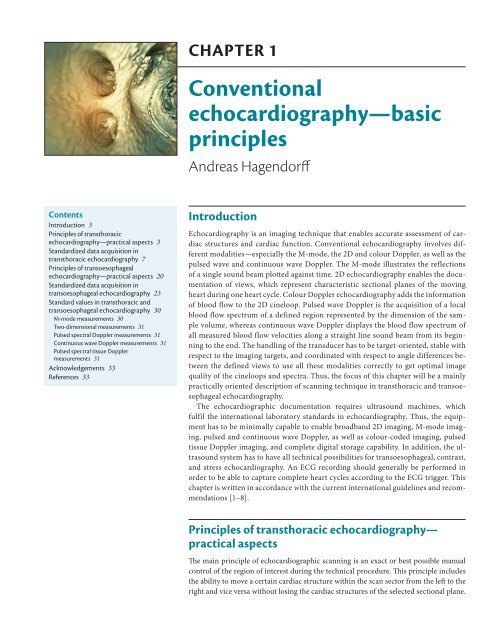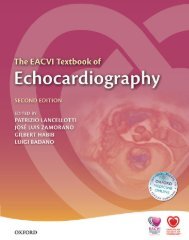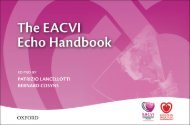ESC Textbook of Cardiovascular Imaging - sample
Discover the ESC Textbook of Cardiovascular Imaging 2nd edition
Discover the ESC Textbook of Cardiovascular Imaging 2nd edition
You also want an ePaper? Increase the reach of your titles
YUMPU automatically turns print PDFs into web optimized ePapers that Google loves.
Chapter 1<br />
Conventional<br />
echocardiography—basic<br />
principles<br />
Andreas Hagendorff<br />
Contents<br />
Introduction 3<br />
Principles <strong>of</strong> transthoracic<br />
echocardiography—practical aspects 3<br />
Standardized data acquisition in<br />
transthoracic echocardiography 7<br />
Principles <strong>of</strong> transoesophageal<br />
echocardiography—practical aspects 20<br />
Standardized data acquisition in<br />
transoesophageal echocardiography 23<br />
Standard values in transthoracic and<br />
transoesophageal echocardiography 30<br />
M-mode measurements 30<br />
Two-dimensional measurements 31<br />
Pulsed spectral Doppler measurements 31<br />
Continuous wave Doppler measurements 31<br />
Pulsed spectral tissue Doppler<br />
measurements 31<br />
Acknowledgements 33<br />
References 33<br />
Introduction<br />
Echocardiography is an imaging technique that enables accurate assessment <strong>of</strong> cardiac<br />
structures and cardiac function. Conventional echocardiography involves different<br />
modalities—especially the M-mode, the 2D and colour Doppler, as well as the<br />
pulsed wave and continuous wave Doppler. The M-mode illustrates the reflections<br />
<strong>of</strong> a single sound beam plotted against time. 2D echocardiography enables the documentation<br />
<strong>of</strong> views, which represent characteristic sectional planes <strong>of</strong> the moving<br />
heart during one heart cycle. Colour Doppler echocardiography adds the information<br />
<strong>of</strong> blood flow to the 2D cineloop. Pulsed wave Doppler is the acquisition <strong>of</strong> a local<br />
blood flow spectrum <strong>of</strong> a defined region represented by the dimension <strong>of</strong> the <strong>sample</strong><br />
volume, whereas continuous wave Doppler displays the blood flow spectrum <strong>of</strong><br />
all measured blood flow velocities along a straight line sound beam from its beginning<br />
to the end. The handling <strong>of</strong> the transducer has to be target-oriented, stable with<br />
respect to the imaging targets, and coordinated with respect to angle differences between<br />
the defined views to use all these modalities correctly to get optimal image<br />
quality <strong>of</strong> the cineloops and spectra. Thus, the focus <strong>of</strong> this chapter will be a mainly<br />
practically oriented description <strong>of</strong> scanning technique in transthoracic and transoesophageal<br />
echocardiography.<br />
The echocardiographic documentation requires ultrasound machines, which<br />
fulfil the international laboratory standards in echocardiography. Thus, the equipment<br />
has to be minimally capable to enable broadband 2D imaging, M-mode imaging,<br />
pulsed and continuous wave Doppler, as well as colour-coded imaging, pulsed<br />
tissue Doppler imaging, and complete digital storage capability. In addition, the ultrasound<br />
system has to have all technical possibilities for transoesophageal, contrast,<br />
and stress echocardiography. An ECG recording should generally be performed in<br />
order to be able to capture complete heart cycles according to the ECG trigger. This<br />
chapter is written in accordance with the current international guidelines and recommendations<br />
[1–8].<br />
Principles <strong>of</strong> transthoracic echocardiography—<br />
practical aspects<br />
The main principle <strong>of</strong> echocardiographic scanning is an exact or best possible manual<br />
control <strong>of</strong> the region <strong>of</strong> interest during the technical procedure. This principle includes<br />
the ability to move a certain cardiac structure within the scan sector from the left to the<br />
right and vice versa without losing the cardiac structures <strong>of</strong> the selected sectional plane.





